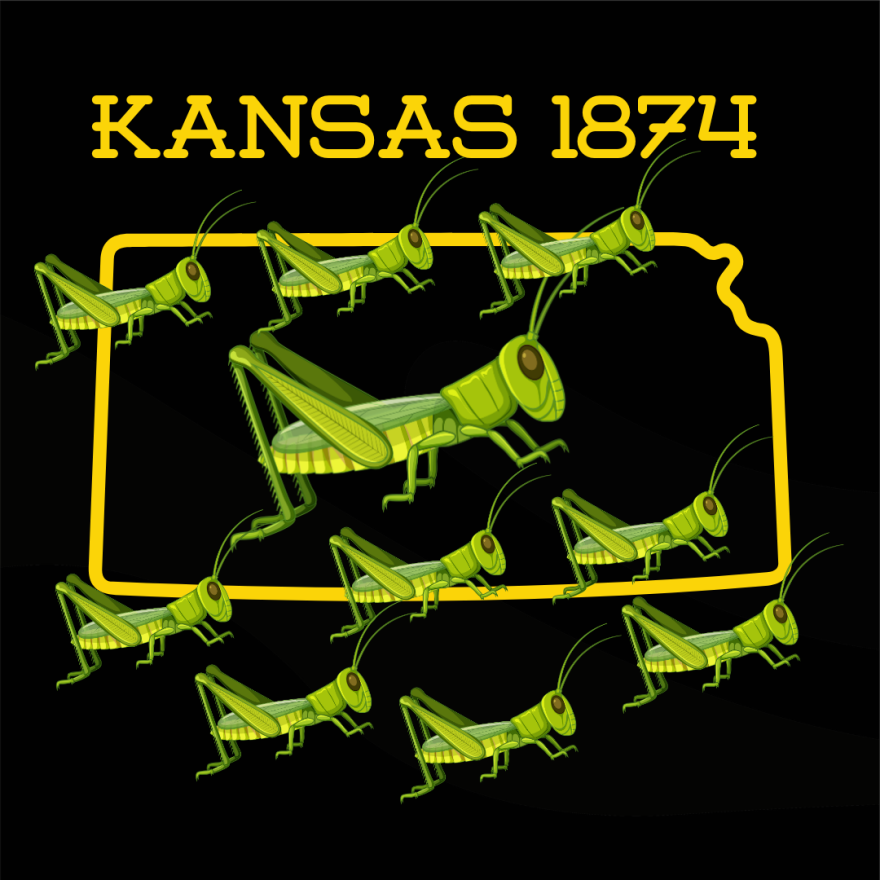It's late July in Kansas and it's incredibly hot. But things could be worse. Indeed, 151 years ago this month, Kansans were facing much more than the heat. As Commentator Adam Hodge tells us, they were also facing an invasion.
(Transcript)
Remembering the Grasshopper Plague of 1874
By Adam Hodge
By 1874, pioneer families in search of inexpensive land and a better life had scattered across the state, planting crops on the prairies and plains. During the spring and early summer of that year, the state received adequate rainfall. Farmers looked ahead to what they hoped would be a bountiful harvest. But it was a hot, dry summer and drought conditions developed.
Then, things went from bad to worse.
In late July, countless grasshoppers – also called Rocky Mountain locusts – descended upon the Great Plains. From the Dakotas in the north, to Texas in the south, the insects arrived in swarms so large that they blocked out the sun.
Witnesses say it sounded... like a rainstorm.
The grasshoppers ate the water-starved crops still in the ground. Paper, tree bark, and wooden tool handles were devoured. They consumed the wool from live sheep. They even ate the clothing right off people’s backs. In some places, hoppers reportedly covered the ground to a depth of several inches.
Locust swarms had troubled Kansas before.
In 1854 – the inaugural year of “Bleeding Kansas” – residents of the Osage Mission, in what is now Neosho County, reported that grasshoppers “came down like a fall of snow.”
Another wave followed in 1855 which destroyed all the crops and devoured “all the grass on the prairies.”
The Emporia News reported that hoppers struck that area in 1860 and wiped out drought-stricken crops. Local swarms periodically followed until the 1874 plague hit much of the state.
Even in the face of Armageddon, Kansans refused to surrender.
Many settlers raked the hoppers into piles - like leaves - and burnt them. But the pests were too numerous for such efforts to do much good. The hoppers usually stayed up to a week in an area and then left as they had arrived, on the wind.
The western part of the state – which was home to many recent settlers – was the hardest hit. Many were not yet established. They needed grain for next year’s crops and to feed their livestock. They also needed provisions and clothing for the coming winter.
Governor Thomas Osborn called a special session of the Legislature because “The western and new-settled portion of the State has been invaded by an army of grasshoppers… thus rendering destitute very many of our citizens, and threatening great suffering among the people in the localities so affected unless speedily relieved.”
Lawmakers convened on September 15, 1874 to provide relief to “destitute people on the frontier.” The Legislature approved $73,000 in state relief bonds.
Pleas for help went across the country. Residents of other states responded by sending money and supplies, which the railroads often delivered free of charge. In addition to food such as pork and beans, they hauled clothing into Kansas. Farmers from across the nation donated rail cars full of barley and corn to assist Kansans with the next year’s planting.
Although Kansans feared the worst, another statewide plague did not follow in 1875. But localized outbreaks did occur that year. The Prairie Band Pottawatomie Nation, for instance, lost most of their crops to grasshoppers. Smaller-scale infestations followed in subsequent years.
Kansans were better prepared. The Legislature passed two measures in 1877 to facilitate the destruction of grasshoppers.
But a much-feared sequel to the 1874 locust plague never materialized.
Even so, the 1874 invasion left its mark on Kansas. Soon thereafter, the Grasshopper River and the town of Grasshopper Falls were disassociated from the devastating pest. The river was renamed the Delaware River. The town is now known as Valley Falls.
###
Commentator Adam Hodge is the Head of Reference at the Kansas Historical Society in Topeka. Learn more about Kansas and its history at KansasHistory.gov.

